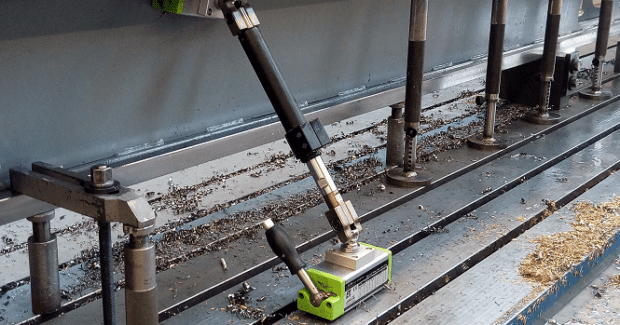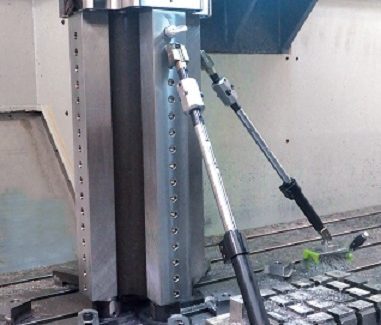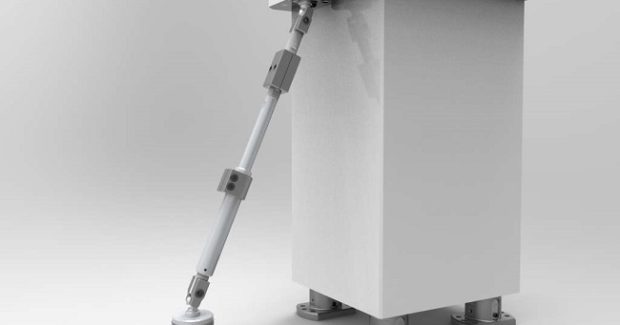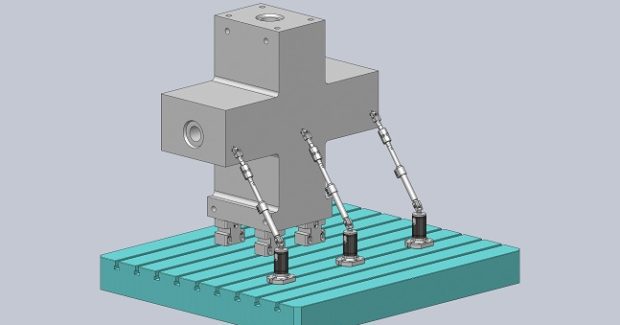Stabilizing Parts in Three Scenarios
Stabilizer systems that adjust quickly, adapt and stack easily, and quickly integrate into existing setups can really pay off by removing the difficult-to-diagnose part movement that makes fine finishes, tight tolerances and clean welds unattainable.
Posted: February 6, 2018
When instability rears its ugly head in a metalworking process, an operator’s mind almost invariably starts thinking . . . “It can’t be the machine or the table – this machine costs thousands of dollars and I haven’t changed anything there. It can’t be the part itself or the fixture, those are naturally rigid. It must be the easily replaced, not-budget-busting tooling or holder.” But what if the tool assembly doesn’t reveal any imperfections? Especially in the case of top heavy, tall parts, or complex weldments, the most rigid table and fixturing may not be able to prevent a large part from vibrating or bending while being worked on, even if you’re performing a finishing process near the base. This kind of part movement is difficult to diagnose, but it has the potential to make fine finishes, tight tolerances and clean welds unattainable. This is where stabilizing the top of a part or an oddly-shaped weldment becomes necessary.
MACHINING
When machining, one of the big indicators that your large part might not be completely stable is if you’re having to back off feeds and speeds to achieve the finishes and tolerances you need. Another indicator is poor tool life. Not only can stabilizing the top of the part improve quality, but if it allows you to accelerate your speeds and feeds, you’ll obviously be more efficient producing your parts. Part variety and production levels influence this decision-making and troubleshooting process. Often, when production levels are high enough, adding a dedicated fixture is justified. However, large parts usually fall into lower production levels and the ability to reuse and reconfigure fixture systems is very beneficial to maintaining profitability. And since large parts often involve expensive material and time investments, it makes it all the more critical to identify the instability problem (or potential problems, before they occur) and find the right solution.
With a costly part, a temporary locating feature or weld tabs and brackets for an extra point of contact to grab onto is an option, but another alternative is gaining popularity: the modularity of stabilizer systems, in terms of both angles/reach and gripping style, is very appealing. In place of modifying parts by moving them from machine to machine – and introducing the chance for error – a stabilizer kit can easily adjust to each new part. Fixed directly to the table via a vice or, even better, a modular fixturing system like the Unilock zero-point system, stabilizer kits adapt to the part or weldment, as opposed to the other way around.
WELDING
Stability is also of the utmost importance in preparing efficient welding processes. When tall parts are welded they are usually laid down on their sides for accessibility and for safety. However, not every part can be easily moved and, as a result, must be welded in place. The welding process itself may not impart much in the way of forces onto the part, but if they are not stable, then their positions relative to one another can be a problem for subsequent operations. This newer stabilizer kit offering is gaining momentum as a solution for this as well. The flexible arm design is capable of adjusting to immobile weldments or frames and securing them throughout multiple processes. Stabilizer systems also make sense for more mobile parts of odd shapes and sizes. No matter the part, these systems are easy to adjust within one job, or in the case that jobs are changing in and out rapidly.
ASSEMBLY
Added stability is beneficial during assembly work as well. Most large part assemblies are handled by overhead cranes that lift parts onto other parts. In some cases, parts are set up next to one another and, if they are tall enough, a falling or tipping hazard may exist. A stabilizer system dramatically improves safety in this setting. In terms of the final position of parts for further work, they can be controlled or fine-tuned by using various methods, from chain come-alongs, hydraulic pushers and pullers, and turnbuckles. A stabilizer system works hand-in-hand with these positioning tactics thanks to fine-adjustment extensions that can be adjusted by rotating the center section or either end piece.
The importance of stability across metalworking applications cannot be overstated. It impacts everything from profitability to employee safety. Stabilizer systems that can adjust quickly and adapt easily go a long way. What’s more, integrating them into existing setups is quick. They stack easily and use a wide variety of gripping forms.















